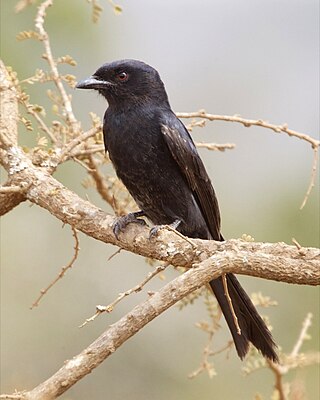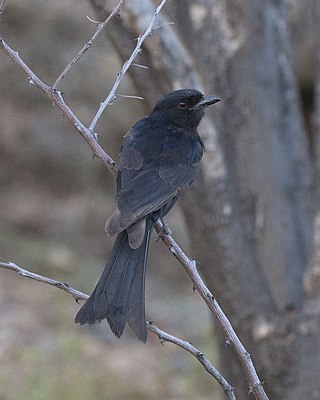
The drongos are a family, Dicruridae, of passerine birds of the Old World tropics. The 31 species in the family are placed in a single genus, Dicrurus.

The fork-tailed drongo, also called the common drongo or African drongo, is a small bird found from the Sahel to South Africa that lives in wooded habitats, particularly woodlands and savannas. They are part of the family Dicruridae and have four recognized subspecies, D. a adsimilis, D. a. apivorus, D. a. fugax and D. a. jubaensis. Like other drongos, the fork-tailed is mostly insectivorous; its diet mainly consists of butterflies, termites, and grasshoppers.

The black drongo is a small Asian passerine bird of the drongo family Dicruridae. It is a common resident breeder in much of tropical southern Asia from southwest Iran through Pakistan, India, Bangladesh and Sri Lanka east to southern China and Indonesia and accidental visitor of Japan. It is an all black bird with a distinctive forked tail and measures 28 cm (11 in) in length. It feeds on insects, and is common in open agricultural areas and light forest throughout its range, perching conspicuously on a bare perch or along power or telephone lines.

The white-bellied drongo is a species of drongo found across the Indian Subcontinent. Like other members of the family Dicruridae, they are insectivorous and mainly black in colour, but with a white belly and vent. Young birds are, however, all black and may be confused with the black drongo, which is smaller and more compact in appearance. The subspecies found in Sri Lanka has white restricted to the vent.

The greater racket-tailed drongo is a medium-sized Asian bird which is distinctive in having elongated outer tail feathers with webbing restricted to the tips. They are placed along with other drongos in the family Dicruridae. They are conspicuous in the forest habitats often perching in the open and by attracting attention with a wide range of loud calls that include perfect imitations of many other birds. One hypothesis suggested is that these vocal imitations may help in the formation of mixed-species foraging flocks, a feature seen in forest bird communities where many insect feeders forage together. These drongos will sometimes steal insect prey caught or disturbed by other foragers in the flock and another idea is that vocal mimicry helps them in diverting the attention of smaller birds to aid their piracy. They are diurnal but are active well before dawn and late at dusk. Owing to their widespread distribution and distinctive regional variation, they have become iconic examples of speciation by isolation and genetic drift.

The green-backed camaroptera, also known as the bleating camaroptera, is a small bird in the family Cisticolidae. This bird is a resident breeder in Africa south of the Sahara Desert. Recent studies suggest this species and the grey-backed camaroptera may be the same species.

The hair-crested drongo is an Asian bird of the family Dicruridae. This species was formerly considered conspecific with Dicrurus bracteatus, for which the name "spangled drongo" – formerly used for both – is now usually reserved. Some authorities include the Sumatran drongo in D. hottentottus as subspecies.

The cardinal woodpecker is a widespread and common resident breeder in much of sub-Saharan Africa. It occurs in a wide range of habitats, ranging from dense forest to thorn bush. It is fairly vocal and is easily identified by its call notes. The sexes are distinguishable by their head patterns.

The cut-throat finch is a common species of estrildid finch found throughout Africa; it is also known as the bearded finch, the ribbon finch, the cut throat, and the weaver finch.

The neddicky, or piping cisticola, is a small passerine bird in the family Cisticolidae, which is native to Africa, southwards of the equator. Its strongholds are the light woodlands and shrublands of the subtropics and temperate regions of southern Africa. The common name, neddicky, is the Afrikaans name for the species.

The southern black flycatcher is a small passerine bird of the genus Melaenornis in the flycatcher family, Muscicapidae, native to open and lightly wooded areas of eastern and southern Africa.

The African cuckoo is a species of cuckoo in the family Cuculidae. It is found in Sub-Saharan Africa where it migrates within the continent, generally arriving and breeding in any one locality during the rainy season. A fairly common bird, the International Union for Conservation of Nature has rated its conservation status as being of "least concern".

The Andaman drongo is a species of bird in the family Dicruridae. The species is endemic to the Andaman Islands of the Indian Ocean. There are two subspecies, the nominate race being found across the main islands of the archipelago, and the race dicruriformis occurring on Great Coco Island and Table Island in the north of the chain

The crow-billed drongo is a species of bird in the family Dicruridae. It is native to moist tropical forests of southeastern Asia where its range extends from India to the Philippines and Indonesia. It is a completely black bird with a shallowly forked tail and is similar in appearance to the black drongo. It breeds between April and June, the cup-shaped nest being built in the fork of a branch by both birds, the female afterwards incubating the eggs. It is a common bird and the IUCN has listed it as "least concern".

The crested drongo is a passerine bird in the family Dicruridae. It is black with a bluish-green sheen, a distinctive crest on the forehead and a forked tail. There are two subspecies; D. f. forficatus is endemic to Madagascar and D. f. potior, which is larger, is found on the Comoro Islands. Its habitat is lowland forests, both dry and humid, and open savannah country. It is a common bird and the IUCN has listed it as "least concern".

The lesser racket-tailed drongo is a species of bird in the family Dicruridae. It is found in the Indian Subcontinent and Southeast Asia.

The white-browed scrub robin, also known as the red-backed scrub-robin, is a species of bird in the family Muscicapidae. It is native to sub-Saharan Africa, especially East and southern Africa. Within range, its Turdus-like song is one of the often-heard sounds of the bush. The flitting of the tail is characteristic of this species, but also of some near relatives.

The African pitta is an Afrotropical bird of the family Pittidae. It is a locally common to uncommon species, resident and migratory in the west, and an intra-African migrant between equatorial and southeastern Africa. They are elusive and hard to observe despite their brightly coloured plumage, and their loud, explosive calls are infrequently heard. The plump, somewhat thrush-like birds forage on leaf litter under the canopy of riparian or coastal forest and thickets, or in climax miombo forest. They spend much time during mornings and at dusk scratching in leaf litter or around termitaria, or may stand motionless for long periods. Following rains breeding birds call and display from the mid-canopy.

The Sri Lanka drongo or Ceylon crested drongo, is a species of bird in the family Dicruridae. It is endemic to Sri Lanka. It was previously considered a subspecies of the greater racket-tailed drongo. Its natural habitats are subtropical or tropical moist lowland and montane forests.

Sharpe's drongo is a species of drongo found in sub-Saharan Africa, where it is distributed from southern South Sudan and western Kenya to the Democratic Republic of the Congo to Nigeria east of the Niger River and south of the Benue River.





















